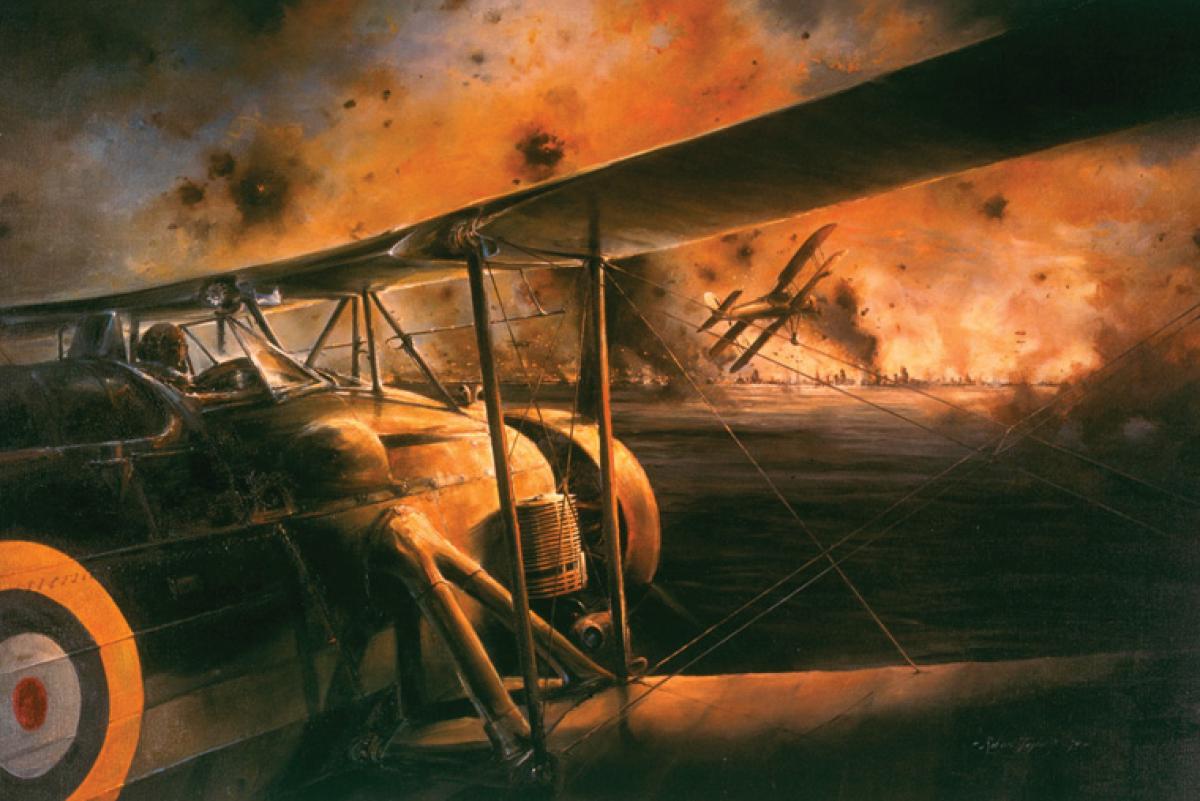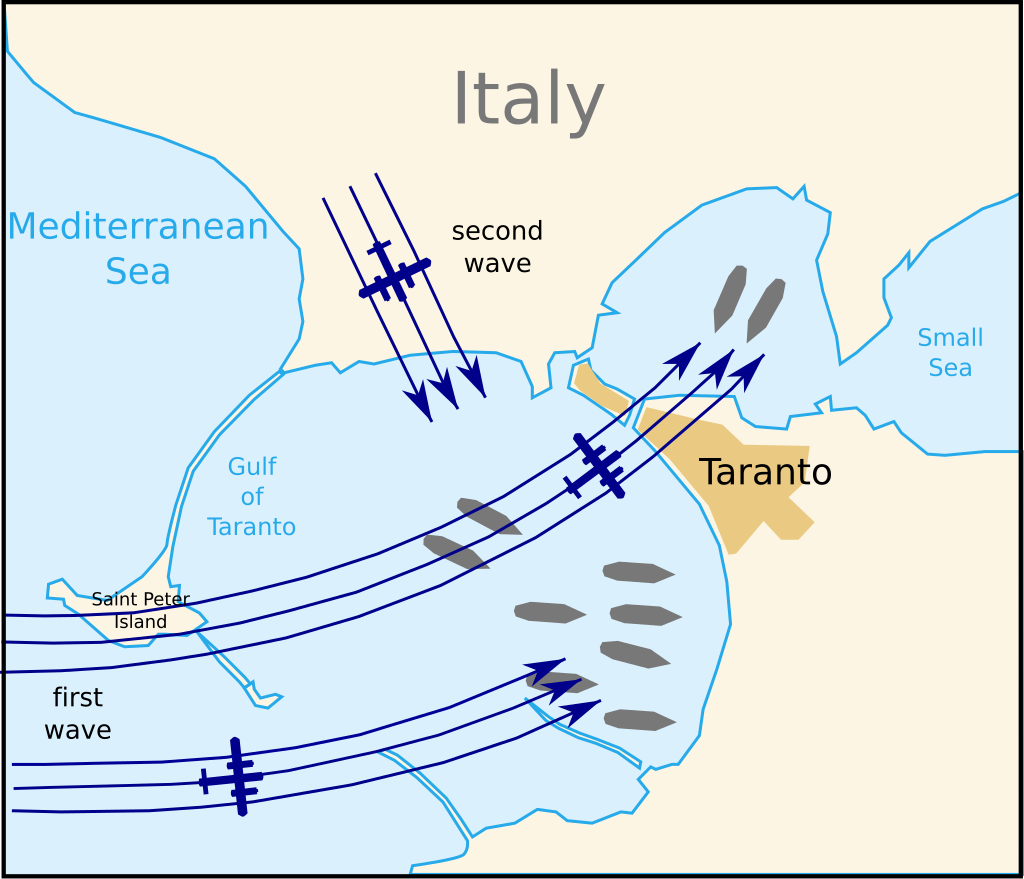Taranto - the Pearl Harbor before Pearl Harbor
Most Americans are not being taught history, and even fewer are taught foreign military history. But if the American Brass (the military and political leaders in charge of our military) had been paying attention -- like the Imperial Japanese had -- the Pearl Harbor attack would not have been as nearly successful.What was Taranto?
It was the location of the Fascist Italian naval fleet in 1940, nearly two years before Pearl Harbor, where the fairly powerful and dangerous Regia Marina lay at anchor. The ships were protected by dense defense of barrage balloons (serving as obstacles for low-flying aircraft), torpedo nets (stopping air-dropped torpedoes before they reached the side of a ship, and many anti-aircraft guns, which the Brits would call Ack-Ack.
The Battle of Taranto took place on the night of 11–12 November 1940 during the Second World War between British naval forces, under Admiral Andrew Cunningham, and Italian naval forces, under Admiral Inigo Campioni. The Royal Navy launched the first all-aircraft ship-to-ship naval attack in history, employing 21 Fairey Swordfish biplane torpedo bombers from the aircraft carrier HMS Illustrious in the Mediterranean Sea.
The attack struck the battle fleet of the Regia Marina at anchor in the harbour of Taranto, using aerial torpedoes despite the shallowness of the water.
The success of this attack augured the ascendancy of naval aviation over the big guns of battleships. According to Admiral Cunningham, "Taranto, and the night of 11–12 November 1940, should be remembered for ever as having shown once and for all that in the Fleet Air Arm the Navy has its most devastating weapon."
...
The Italian fleet lost half of its capital ships in one night; the next day, the Regia Marina transferred its undamaged ships from Taranto to Naples to protect them from similar attacks, until the defences at Taranto (mainly the anti-torpedo nets) were brought up to adequate levels to protect them from further attacks of the same kind (which happened between March and May 1941).
Repairs to Littorio took about four months, to Duilio seven months; Conte di Cavour required extensive salvage work and her repairs were incomplete when Italy surrendered in 1943.
Cunningham wrote after the attack: "The Taranto show has freed up our hands considerably & I hope now to shake these damned Itiys up a bit. I don't think their remaining three battleships will face us and if they do I'm quite prepared to take them on with only two."
Indeed, the balance of power had swung to the British Mediterranean Fleet which now enjoyed more operational freedom: when previously forced to operate as one unit to match Italian capital ships, they could now split into two battlegroups; each built around one aircraft carrier and two battleships.
Some Americans were paying attention, but their warnings fell on deaf ears.
Lieutenant Commander Opie still was busy in the Mediterranean. In December he had sailed on board HMS Jervis, and in January 1941 he was on board the Warspite when the nearby Illustrious was attacked by swarms of Stuka dive bombers. Opie wrote a report on the battle as well as a personal letter to his boss, Captain Alan G. Kirk, the U.S. naval attaché in London. He told Kirk, “I am not trying to drum up my own trade but I honestly feel that I should fly to Hawaii and talk to the boys there on war experiences and how to train to meet the lessons learned.” He received no answer.




Comments (8)
Tarantino is a film director that is not everybodys cuppa, but he was good in pulp fiction I would say :)
I kinda suspect that Carvalo, once I humiliated him (as he needed to be) is using sock accounts to throw rocks.
Either that, or there are posters who are mysteriously and identically unhinged, deviant and outspoken.
I thought the military anecdote thread was going pretty good until the Deviant(s) arrived.
This seems like a better battlespace, as they call it.
You two rock!
Gotta have planes above the ships either for defense or attack.
It's almost a pity aesthetically speaking that the huge war ships a la Littorio and Prince of Wales
was only a once in a lifetime historical happening. It's a bit King Kong this biplanes sinking a giant like that init... Prefer the honest big gun battle ship to ship.
But military principles: Mass, Surprise and so forth, remain constants. One principle is the high ground, which is exactly why mastery of the air is an absolute requirement. And soon we will have combat in space, based on that principle.
@Tiger, I am pleased and surprised. You don't see that many females that have an interest in war history.
Perhaps your username means something more than just a little flying thing, but one of these:
DeHaviland Tiger Moth.
Gandalf was right. You hobbits are indeed remarkable creatures. ;-)
'Dementors? In Little Whinging''
@ InTheCountry
Well, word has it that the USA was working on Signals Intelligence before U.S. involvement in the war. A huge section of the American population wanted to stay out of the war. The 1927 transactlantic solo hero Charles Lindberg was leading the charge to keep us out of the war, so convincing the American people of the need to get involved would require a real Bloody Shirt, something to wave at a crowd and get them riled.
Seems we've had them for as long as there have been wars. For the Mexican-American War, the cry was Remember the Alamo. For the Spanish-American War, it was Remember the Maine. For WWI it was the Lusitania and the Zimmerman telegram.
There was some discussion, and some still suspect, that the very top of American and British governments knew of the impending attack on Pearl Harbor and pulled the carriers out, knowing that the loss of the Pacific Fleet would be the Bloody Shirt they needed to get the Americans into the War.
See: MAGIC & ENIGMA
I'm not sure if that's true or not, but knowing what we know about lying governments these days, it's plausible.